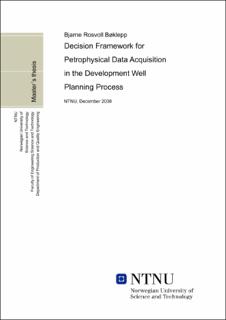| dc.description.abstract | As the Heidrun field has reached a decline from the initial hydrocarbon production plateau, there is an increasing need for alternative well solutions to be able to recover bypassed reserves in a cost effective manner. New wells or drainage points planned are continuously focusing on smaller and often bypassed reserve volumes. As these volumes are getting smaller and hence harder both to identify and to hit, the well planning process is becoming ever more comprehensive and demanding.
As raw or treated sea water and produced water (all having different salinities) is being injected into the reservoir to compensate for reservoir pressure depletion and to increase the total hydrocarbon recovery, the reservoir parameters are altered. Further, movement of fluids (including gas) in the reservoir due to production and injection has changed the properties of the reservoir from its initial state, with a typical two phase fluid system, easily recognized and interpreted by the petrophysicist, into a mixed fluid system containing both oil, fractions of gas and water of unknown or salinity. The previous data acquisition strategy documentation did not cover these newly discovered challenges.
The main objective of this master thesis has been to develop a decision framework for petrophysical data acquisition in the development well planning process. The main intention is to ensure a flexible data acquisition planning process covering both short and long term needs regarding reservoir characterization, while managing new challenges related to the petrophysical interpretation. Further, the process should ensure well placement optimization during the drilling operation, fulfill minimum requirements with regards to data quality and quantity, while minimizing operational risk and time consumption.
As a foundation for the decision framework, an evaluation of the downhole data acquisition methods and techniques available was conducted and an extensive general overview of each method’s advantages and disadvantages was made. Based on the conclusions from this evaluation, the prevailing perception in the industry favoring wireline to Logging While Drilling should be challenged. A stochastic simulation model of the petrophysical evaluation routine was developed and this model generally shows that uncertainty in the input parameters as well as in the model algorithms has just as big impact on the evaluation results as the uncertainties in the raw measurements. Several decision making methods and techniques were evaluated and utilized during several actual well planning processes, from simple flowcharts and decision trees to more complex multi-criteria decision making methods, to test each method’s applicability in the well planning context.
The main conclusion is that data acquisition planning should primarily be based on the premises and the nature of the well to be drilled. Very often, physical limitations and specific well requirements are qualifying one type of data acquisition while disqualifying other methods directly. | en_US |
